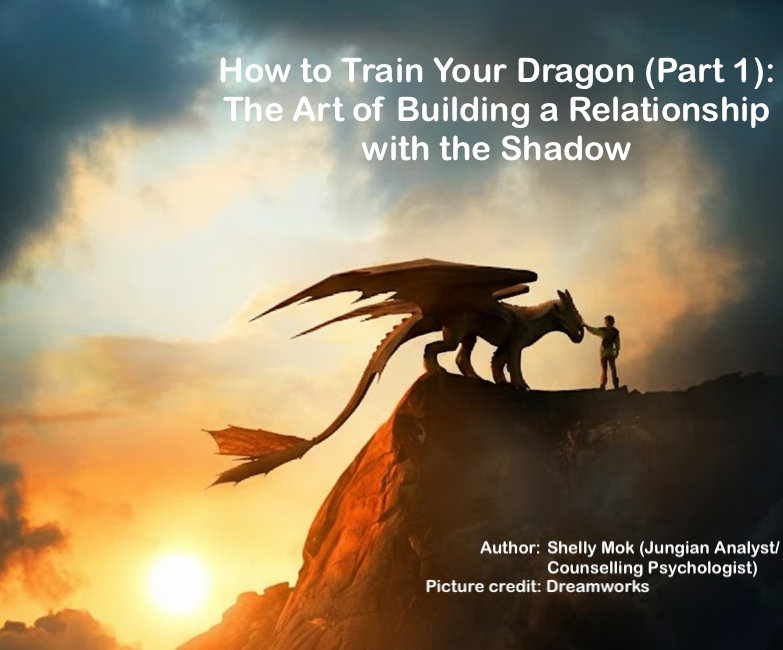How to Train Your Dragon (Part 1): The Art of Building a Relationship with the Shadow
2025年9月 Author: Shelly Mok
What is the Shadow?
The shadow represents the unconscious, encompassing all parts of ourselves that we don’t want to acknowledge and become aware of. It includes our dark sides—things we feel ashamed of, such as fears, anger, vulnerabilities, aggressiveness, and other negative emotions or traits. It also contains unrealized potential that we have not accepted. These parts of ourselves do not disappear simply because we refuse to acknowledge them; instead, they accumulate in the unconscious and form the shadow.
The movie How to Train Your Dragon begins in darkness, hatred, and a war between humans and dragons. When people fail to become conscious of, understand, and accept their own fears and aggression, they may unconsciously project these onto others, a process known as shadow projection. This causes them to see others as evil, hostile, or repulsive. At the start of the movie, we see that the Viking chief dedicated his life and mission to exterminating the dragons, leading his tribe into hatred and conflict. The Vikings blamed the dragons for all their problems, seeing them as pests. This is a classic example of collective shadow projection. Similarly, during World War II, Hitler blamed Germany's problems on the Jewish people, portraying them as parasites to be destroyed.
As the son of the chief, the protagonist Hiccup initially embodied this collective shadow projection, channeling the Vikings’ fear and hatred toward the dragons.
The Turning Point: The Mirror of Night Fury’s Eyes
"I couldn’t kill him because he looked as frightened as I was. I looked at him… and I saw myself." ------ Hiccup
The story takes a pivotal turn when Hiccup encountered the Night Fury, later named Toothless. Determined to prove himself a worthy Viking, Hiccup invented a contraption to capture the elusive and deadly Night Fury. Under the cover of darkness, he successfully shot it down. However, when he approached the helpless dragon with a dagger in hand, ready to kill, he saw his own fear and inner struggle reflected in Toothless’s eyes. At that moment, an emotional connection is formed. The terrifying enemy transformed into an understandable being. Empathy allowed Hiccup to lower his dagger, a decision that led him to a newfound understanding of himself—he could not kill dragons. He just could not.
Night Fury: The Symbol of the Shadow, Shadow Projection, and Shadow Withdraw
The Night Fury symbolized the shadow. Mysterious and terrifying, it embodied the unknown. No one had ever seen a Night Fury up close before Hiccup, and even the Viking’s dragon manual contained no record of its appearance. This signified that Hiccup was the first to confront the collective shadow of the Vikings. When Hiccup released the ropes binding Night Fury, it marked the beginning of withdrawing the projection.
Hiccup soon discovered that the fearsome Night Fury was actually a dragon without teeth, and he renamed it Toothless. This "toothless" dragon symbolized the neutralization of aggression. Through a ritualistic drawing in the sand, followed by a synchronized dance of mirroring each other’s movements, Hiccup and Toothless establish trust and mutual understanding. This symbolized the integration of the shadow.
Flying with Toothless: The Gift of the Shadow
The shadow is not only something to be understood but also something that can be transformed into potential and strength. Through close interaction, Hiccup gradually learnt about Toothless’s nature. Fear turned into courage, wisdom, and empathy, and Hiccup channels his creativity to craft a mechanical tail for Toothless, who had lost part of his own. This allowed Toothless to fly again. Hiccup also invented other tools, enabling himself to fly alongside Toothless. Through trial, error, and adaptation, they become trusted partners and allies, eventually saving both the Vikings and the dragons. This demonstrates that when Hiccup withdrew his projections, the shadow ceased to be frightening and instead became a bridge to wholeness. By integrating shadow in his inner world, Hiccup uncovered the gifts hidden within the shadow.
Taming Dragons: Building Relationships
At the climax of the movie, Hiccup nearly lost his life while saving his tribe, while Toothless risked his own life, saving Hiccup. This experience allowed the entire Viking tribe to see a different side of the dragons. The chief acknowledged his son and reconciled with the dragons, rebuilding their relationship. Hiccup awakened from unconsciousness to find that the tribe and dragons were now living in harmony. The dragons, once seen as pests, had become pets. The wordplay in English is subtle but profound: one letter transforms the meaning entirely. This coexistence between humans and dragons was the result of shadow integration.
It was interesting to note that Hiccup lost part of his left leg, mirroring Toothless’s lost left tail. This shared loss and vulnerability served as a reminder of how Hiccup and Toothless hurt, saved, and ultimately relied on each other.
The Meaning of Taming Dragons
How to Train Your Dragon began in darkness and hatred but ended in light and harmony, symbolizing the awakening of consciousness and the integration of life. I prefer the Chinese translation “馴龍記” (The Tale of Taming Dragons) to the English title. The word "馴" (tame) reminds me of the fox's explanation to the Little Prince: "To tame means to establish ties." Once the Little Prince tames the fox, they form a unique bond, and each becomes irreplaceably important to the other. In contrast, the word "train" carries the connotation of hierarchy and control, upper and lower, implying a relationship of dominance.
Growth and integration in life are not achieved through control, domination, or suppression. Instead, they come from building a relationship with every part of ourselves, including our shadow. This is the true meaning of taming dragons.
Author: Shelly Mok, Jungnian Analyst/ Counselling Psychologist
Picture: Dreamworks

